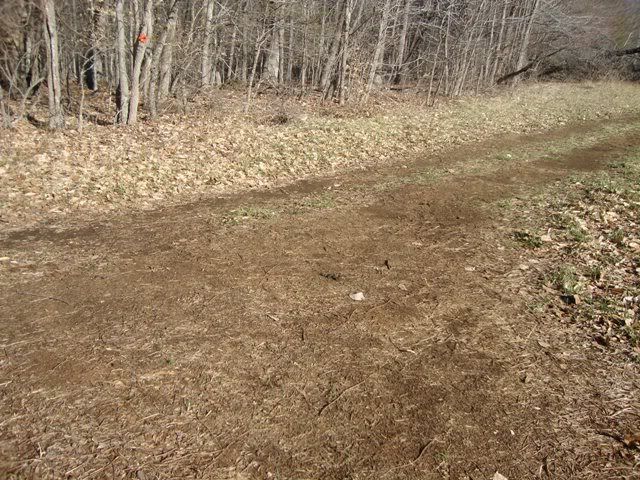It was an incredible morning. Calm, clear....temperatures in the low 50s. All-in-all a day that makes one thankful to be outside!
We experienced some pretty heavy rains here about two days ago, which also made me excited to be in the field. Not only could the warm rains bring out the amphibians (I heard upland chorus frogs and spring peepers calling today), one of the best parts about heavy rain is that it's nature's erasure. The trails and stream banks are all wiped clean and ready for new tracks to be registered in the soil.
I came to a crossroads, where two trails intersected (one heading mostly east-west, the other heading north-south). To the northeast and east of the intersection was a small patch of old field. Periodically mowed by the county, probably a pasture many years ago. While to the north, west and south was all deciduous hardwood forest.
Now it's no secret that mammals like to follow the easiest walking path possible (including us). So human trails are always a good place to find tracks (particularly deer). It's also no secret that predators also often follow trails and will skirt the edges of woodland habitat. As such, woodland edges, adjacent to fields or grassland are usually great spots to put up a camera or look for tracks.
Today this held true. As I walked the muddy trail that ran between forest and field, I noticed that a coyote (Canis latrans) had left a message at the trail intersection.
A small pile of scat, deposited perfectly at the crossroads. Now any other critter that took a sniff at this little pile of poop (including another coyote) would know this individual had been here.
NOTE: the key used for scale in each picture is exactly 3 inches long.
I broke the scat apart with a stick (btw...never touch wild animal scat with your bare hand unless you have a inkling to see what it might feel like to have tapeworms or roundworms squirming around in your belly).
Lots of hair. I couldn't really tell what kind of hair. Rabbit? Deer?
Not long after that, I found the tracks. Coyote tracks are pretty hard to distinguish from domestic dog and, actually, I can't be certain these aren't dog tracks. My only evidence to the contrary was the animal hair in the scat nearby (although an old barn dog could have been scavenging roadkill deer), and the fact that there were no human footprints around, so it didn't seem as if someone had brought their dog out for a walk.
Also, domestic dog tracks are more splayed then wild canids and the trail they leaves seems to run this-way and that across a given path, with seemingly little purpose. I would imagine wild canids don't have the luxury of wandering aimlessly after every smell they encounter. They appear to be more purposeful in their trails: straight lines, toes rarely splayed unless running, and toes pointing forward moreso than a domestic dog.
The 'yote tracks went on for some time and I was able to follow them pretty clearly. At one point, it appeared that a fox may have also run this route (gray fox are very common here).
Eventually, they turned down into the woods towards a stream. Here they stopped periodically near a number of small areas where the 'yote dug alittle bit for something (probably a sniff of food coaxed him to do this).
What type of food he was after, I'm not sure. They have a pretty general diet.
At that point, I noticed the tracks turned back on themselves (it's hard to see the tracks facing opposite directions in the picture below).
After that, I lost them...
Further reading on Mammal Tracks and Sign:
Halfpenny and Biesiot. 1986. A Field Guide to Mammal Tracking. Johnson's Publishing Company. Boulder, Colorado.








No comments:
Post a Comment